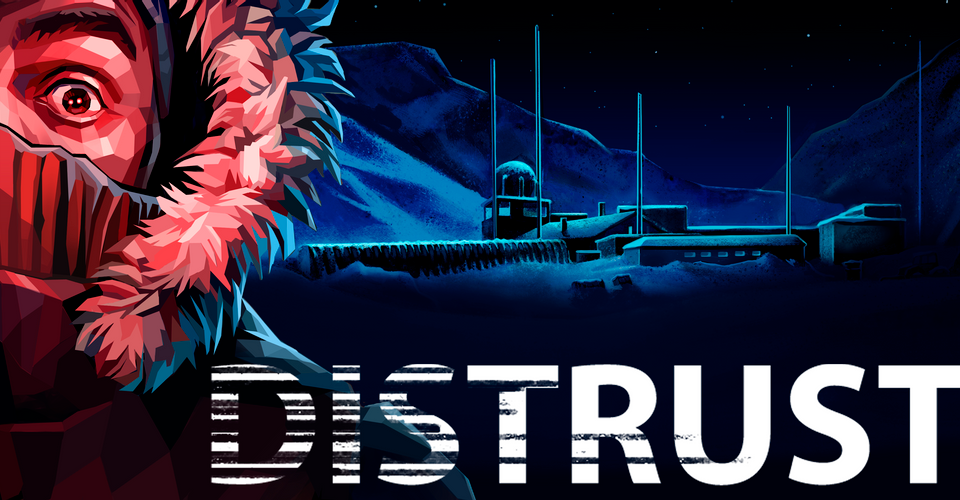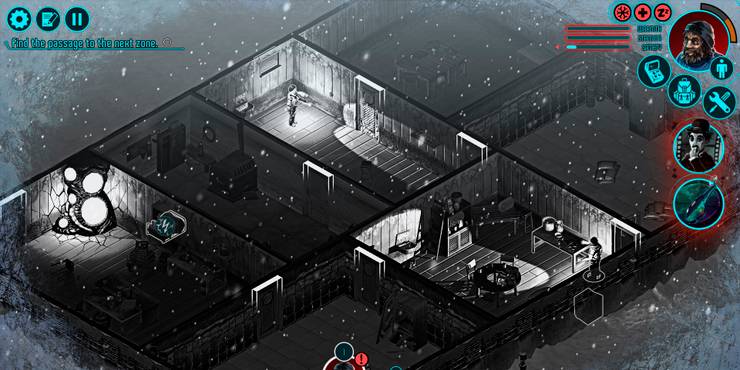Distrust Review: The Horror of Chores

Distrust is a game where the title itself deceives the player. It asks the question “who can you trust?” but in a single-player game, the answer is always “myself.” Distrust is an isometric survival game where players control two (sometimes three) researchers in an Arctic base, tasked with finding a way to escape a nightmarish alien entity. It wears its influences on its sleeves but to continue the metaphor, its outfit is not suited for this climate.
The developers of Distrust, Cheerdealers, marketed the game as “Inspired by John Carpenter’s The Thing.” For those unfamiliar, The Thing is often considered one of the greatest horror films of all time. Though it was widely panned in theaters, the 1982 classic found an audience when it was released on home video. The unique setting of a desolate Antarctic base, the beautiful and haunting synth score, and amazing creature effects from Rob Bottin all contributed to The Thing’s cult status. But perhaps the film’s greatest strength is Carpenter’s ability to tap into the fear and paranoia felt by the crew of researchers being mimicked and stalked by the alien “thing” in such a visceral way, that the viewer feels it too. This feeling makes The Thing, and it breaks Distrust.
The Thing and Distrust have a lot in common, and some of it works for the game’s favor. The setting for one, is expertly crafted. Though the action takes place on the opposite pole, the darkness and chill of arctic/antarctic weather is palpable. The characters must constantly moderate their warmth, splitting time between journeying outside and hanging out in buildings with burning furnaces. When the furnaces run low, they must find wood or coal to burn, either by searching boxes or breaking down empty ones for kindling. It’s a mechanic that players familiar with survival games will be used to, and it works well with the story.

In addition to moderating warmth, players must also keep note of their Stamina and Satiety bars. These can be filled back up by sleeping and eating respectively. While this is traditional “survival game” game play, it almost immediately feels out of place here, more like a chore than something that feels urgent and scary. Players will find themselves constantly hunting for food, and rushing to get a character to an empty bed or couch. These actions detract from the main story of the game in incredibly frustrating fashion.
Diving further into the crux of the gameplay, Distrust is a survival game, though noticeably more traditional than modern fair. Unlike Red Dead Redemption 2’s survival elements, where hunting becomes a necessity but also a welcome break to the narrative, Distrust focuses primarily on keeping characters alive while completing objectives. But because the objectives are so sparse and vague: i.e. escape to the next zone, completing them ends up feeling like doing camp chores.
Related: Red Dead Redemption 2 Hunting Tips, Tricks, and Hints
The game is set in an isometric POV, far above the player characters, taking away the setting’s naturally claustrophobic and spooky elements. The point of view might be forgivable if the camera and controls were better adapted to console. Perhaps on PC the game might feel more at home, but on PS4, the movement is finicky and unforgiving.

The story feels just as “removed” as the gameplay. The game simply drops you right in, which is a refreshing change of pace from most games that feature a 20-minute opening cutscene. Unfortunately this is a game that could have benefited from some backstory. The characters are personality-less blobs, their only difference being stats and perks that make them unique for replayability’s sake. It was the camaraderie and conflicting opinions of the crew in The Thing that gave the film its charm; here, all of that is missing.
In addition to typical survival elements, the characters must avoid alien entities on their escape mission. Contact with the aliens over time causes hallucinations, of which there are many variations. One for instance, distorts the map, causing it to bubble and shrink in certain areas. Another causes the character to lash out in a fit of rage. The player must switch between characters to parse together what is real and what is fantasy. It’s an interesting mechanic, that to put it simply, doesn’t work. Though there’s plenty of variety, all of the hallucinations are relatively easy to solve and each is far from scary or unsettling. Each becomes another nuisance to surmount rather than a difficulty spike that injects life into this Thing imitation.
Perhaps Distrust’s greatest strength is its replayability. The levels are randomly generated, meaning no playthrough is alike. The layout of each of the game’s 6 stages will be different, with different buildings and map layouts, item spawns, and objectives. For those who strive to complete games multiple times and unlock all endings and characters, this game is the perfect match.

Additionally, borrowing from Carpenter’s synth influences, the soundtrack is a moody, muted masterpiece. It mimics the gameplay at all the right moments, perfectly accompanying the feeling of dread and isolation. If only it was made for a game that, as a whole, better represents the best of Carpenter’s classic.
Distrust is a strange game to claim influence from The Thing. While its setting is certainly inspired, it misses the present themes. Single-player survival was far from what made The Thing cult; it was the paranoia and distrust that settled among the researchers. But there’s no distrust here, only half-baked hallucinations that add little to the survival gameplay. Switching perspectives instantly gives the player a better grasp of reality and with that, dispels the illusion of fear. The characters have no voice, each one more forgettable than the last, and the aliens that haunt them are far from Bottin’s grotesque monstronsities.
Distrust is a disappointment; on influence alone a game is not made. The Thing would be better served as a multiplayer co-op title, think Alien: Isolation meets The Forest in the arctic. For those looking for an experience akin to the film, The Thing: Infection at Outpost 31 is a phenomenal board game that truly captures the spirit and themes. Distrust is a generic isometric survival game wearing the clothes of The Thing… but upon closer look, it’s an impostor.
More: Nidhogg 2 Switch Review – A Match Made in Heaven
Distrust is available now on PS4 for $14.99 and Steam for $11.99. Screen Rant was provided with a PS4 download code for the purposes of this review.
About The Author


















